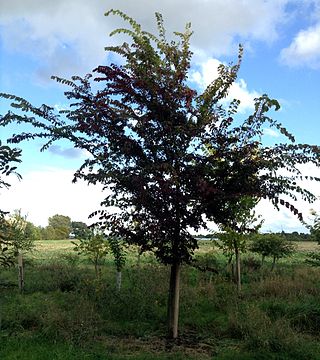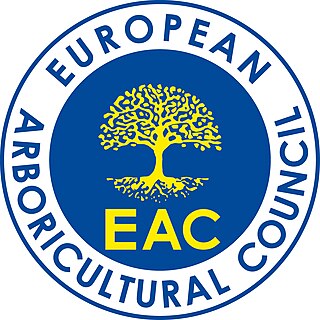
Arboriculture is the cultivation, management, and study of individual trees, shrubs, vines, and other perennial woody plants. The science of arboriculture studies how these plants grow and respond to cultural practices and to their environment. The practice of arboriculture includes cultural techniques such as selection, planting, training, fertilization, pest and pathogen control, pruning, shaping, and removal.

An arborist, tree surgeon, or arboriculturist, is a professional in the practice of arboriculture, which is the cultivation, management, and study of individual trees, shrubs, vines, and other perennial woody plants in dendrology and horticulture.

Urban forestry is the care and management of single trees and tree populations in urban settings for the purpose of improving the urban environment. Urban forestry involves both planning and management, including the programming of care and maintenance operations of the urban forest. Urban forestry advocates the role of trees as a critical part of the urban infrastructure. Urban foresters plant and maintain trees, support appropriate tree and forest preservation, conduct research and promote the many benefits trees provide. Urban forestry is practiced by municipal and commercial arborists, municipal and utility foresters, environmental policymakers, city planners, consultants, educators, researchers and community activists.
Articles on forestry topics include:.
The International Society of Arboriculture, commonly known as ISA, is an international non-profit organization headquartered in Atlanta, Georgia, United States. The ISA serves the tree care industry as a paid membership association and a credentialing organization that promotes the professional practice of arboriculture. ISA focuses on providing research, technology, and education opportunities for tree care professionals to develop their arboricultural expertise. ISA also works to educate the general public about the benefits of trees and the need for proper tree care.

An urban forest is a forest, or a collection of trees, that grow within a city, town or a suburb. In a wider sense, it may include any kind of woody plant vegetation growing in and around human settlements. As opposed to a forest park, whose ecosystems are also inherited from wilderness leftovers, urban forests often lack amenities like public bathrooms, paved paths, or sometimes clear borders which are distinct features of parks. Care and management of urban forests is called urban forestry. Urban forests can be privately and publicly owned. Some municipal forests may be located outside of the town or city to which they belong.

Ulmus 'Frontier' is an American hybrid cultivar, a United States National Arboretum introduction derived from a crossing of the European Field Elm Ulmus minor with the Chinese Elm Ulmus parvifolia in 1971. Released in 1990, the tree is a rare example of the hybridization of spring- and autumn-flowering elms. Tested in the US National Elm Trial coordinated by Colorado State University, 'Frontier' averaged a survival rate of 74% after 10 years.
Ulmus 'Morton Plainsman' is a hybrid cultivar raised by the Morton Arboretum from a crossing of Siberian Elm and a Japanese Elm grown from openly pollinated seed donated by the Agriculture Canada Research Station at Morden, Manitoba. Tested in the US National Elm Trial coordinated by Colorado State University, Vanguard averaged a survival rate of 78% after 10 years.

Ulmus 'Morton Red Tip' is a hybrid cultivar raised by the Morton Arboretum from an open pollination of Ulmus 'Morton'. The tree has occasionally been reported as a hybrid of Accolade with the Siberian Elm Ulmus pumila, an error probably owing to the commercial propagation of the tree by grafting onto U. pumila rootstocks. Tested in the US National Elm Trial coordinated by Colorado State University, Danada Charm averaged a survival rate of 77.5% after 10 years.

Ulmus 'Morton Stalwart', is a Morton Arboretum hybrid cultivar arising from a controlled crossing of Accolade with the hybrid of a Field Elm U. minor from eastern Russia and a Siberian Elm U. pumila. Tested in the US National Elm Trial coordinated by Colorado State University, Commendation averaged a survival rate of 85% after 10 years.
The Royal Forestry Society (RFS) is an educational charity and one of the oldest membership organisations in England, Wales and Northern Ireland for those actively involved in woodland management.

Ulmus 'Patriot' is a hybrid cultivar raised by the United States National Arboretum in 1980. Derived from a crossing of the American hybrid 'Urban' with the Wilson's Elm cultivar 'Prospector', 'Patriot' was released to commerce, free of patent restrictions, in 1993. Tested in the US National Elm Trial coordinated by Colorado State University, 'Patriot' averaged a survival rate of 85% after 10 years.

The Davey Tree Expert Company, also known as Davey Tree, is an American multinational employee owned corporation. The company's main services are tree care, commercial grounds, utility and consulting. It has employees throughout the United States and Canada.

The European Arboricultural Council (EAC) based in Bad Honnef, Germany is a forum where delegates from a wide range of arboricultural organizations throughout Europe meet. The goal of the EAC is to elevate the status and to raise the professional level of competence within arboriculture. This objective is carried out by liaising on matters ranging from research and education to successful tree establishment and the improvement of safe working practices.
The Master Arborist or Board Certified Master Arborist credential identifies professional arborists who have attained the highest level of arboriculture offered by the International Society of Arboriculture(ISA) and one of the two top levels in the field. There are several paths to the Board Certified Master Arborist, but typically on average each has been an ISA Certified Arborist a minimum of three to five years before qualifying for the exam. The certification began as a result of the need to distinguish the top few arborists and allow others to identify those with superior credentials. The ISA added specialty certifications of Utility Specialist, for those maintaining vegetation around electric utility wires, Municipal Specialist, for those with additional experience managing public urban trees.

George Ware, Ph.D. (1924–2010) was an American dendrologist and former research director of the Morton Arboretum Illinois who specialized in the evaluation of Asiatic species of elm as urban trees.
Nina Lauren Bassuk is a professor and program leader of the Urban Horticulture Institute at Cornell University.

Tree care is the application of arboricultural methods like pruning, trimming, and felling/thinning in built environments. Road verge, greenways, backyard and park woody vegetation are at the center of attention for the tree care industry. Landscape architecture and urban forestry also set high demands on professional tree care. High safety standards against the dangers of tree care have helped the industry evolve. Especially felling in space-limited environments poses significant risks: the vicinity of power or telephone lines, insufficient protective gear and narrow felling zones with endangered nearby buildings, parking cars, etc.. The required equipment and experience usually transcends private means and is often considered too costly as a permanent part of the public infrastructure. In singular cases, traditional tools like handsaws may suffice, but large-scale tree care usually calls for heavy machinery like cranes, bucket trucks, harvesters, and woodchippers.

Populus simonii, Simon's poplar, Simon poplar, or Chinese cottonwood, is a species of poplar native to northeast China and to Mongolia, and commonly planted as a street tree in cool temperate areas of Europe. There have been introductions into North America, South Africa, Australia and New Zealand.
Cecil C. Konijnendijk is a Dutch researcher, educator, advisor, and writer working within the fields of urban forestry and urban greening. He co-directs the Nature Based Solutions Institute and is an Honorary Professor at the University of British Columbia's Faculty of Forestry.













